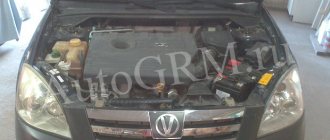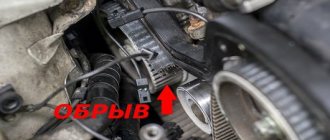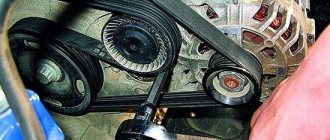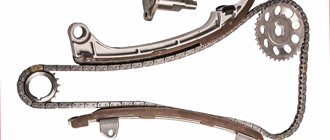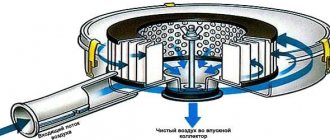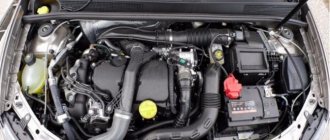Renault Fluence: 1.6 engine
The 1.6 Renault Fluence engine is a 4-cylinder 16-valve engine with a power of 106 hp. At the same time, in models equipped with a CVT, the car’s power increases (such engine models are equipped with the abbreviation CVT). The same engines are installed on Renault Duster cars. Cars of different engine sizes also differ in the timing device - Fluence 1.6 has a timing belt, while Fluence 2.0 has a more practical and reliable chain.
Engine characteristics Renault Fluence 1.6:
- Number of valves: 16
- Number of cylinders: 4
- Power: 106 hp
- Engine displacement is 1598 cm3
- Torque: at 4250 rpm. 145 Nm
How is the Renault Fluence timing belt replaced?
The sequence of the process of replacing the timing belt on Renault Fluence depends on the type of engine - gasoline or diesel. But, in general, the replacement steps on cars with different types of engines are similar and differ only in some details. You can do the replacement yourself or use the services of specialists.
Let's look at how to change the timing belt using the example of a car with a K4M 1.6 liter gasoline engine. Before starting work, you will need to purchase a Renault Fluence timing kit. The kit consists of the belt itself, bolts and a roller.
Renault Fluence: do-it-yourself timing belt replacement
Removing the old timing belt:
- Raise the car
- Remove the engine protection and remove the right fender liner
- Raise the engine using a jack, resting it on the pan near the crankshaft pulley.
- Unscrew the upper mount at the engine mount, unscrew the supporting support
- Disconnect and move aside the fuel line fitting
- Remove the plug from the end of the camshaft at the intake valves (it’s easy to find - this plug is the largest in diameter)
- Engage fifth gear, then slowly rotate the wheel drive to the hub clockwise with a 30mm wrench (look from the engine compartment)
- Align the shafts along the intake camshaft (where the plug was removed) in one line with notches - in this case, the notches must be positioned below the camshaft axis
- Unscrew the two nuts and three bolts with a 13mm wrench, after which you can remove the upper protective cover from the timing belt
- Remove the tension roller and alternator belt
- Put it back into fifth gear, after which your partner must press the brake all the way
- At the same time, unscrew the bolt securing the crankshaft damper pulley using an 18mm wrench and remove the pulley.
- Remove the 4 bolts from the lower plastic timing belt cover and dismantle it
- Fix the camshaft toothed pulleys to prevent rotation - this can be done using two washers and an M10x50 bolt with a nut (it is also recommended to make additional marks on the cover body and on the pulleys with a marker)
- Also, before removing the timing belt, you need to use a marker to place marks on the engine housing and on the crankshaft timing pulley.
- Unscrew the timing roller nut with a size 13 wrench and remove the belt
- Unscrew the bolt with a T40 key
- Remove timing belt idler pulley
- Next, before removing the tension roller, you need to note its position in order to correctly set the belt tension in the future.
Installing a new timing belt:
- Secure the idler and then the tension rollers
- It is necessary to fix the preload with a self-tapping screw, focusing on the position of the old tensioner
- The timing belt itself only needs to be placed on the lower part of the crankshaft toothed pulley - this will simplify installation of the belt on the roller
- Rotate the crankshaft through the wheel hub - during the process you need to ensure that the marks on the pulleys match
- Install a new tensioner roller with the self-tensioning mechanism of the drive poly-V-belt
- Install the bottom plastic cover
- Replace the crankshaft damper pulley and secure it with a sufficiently strong tension with a new bolt with a thick washer (it is included in the kit) - during the procedure you need to engage fifth gear again, while the assistant must press the brake pedal firmly
- Put on the drive belt.
- Remove the retaining bolt and washers from the camshaft timing pulleys.
- Close the top cover (duralumin) of the timing belt
- Tighten the support support and the upper mount of the engine mount
- Connect the fuel line fitting
- Insert a new plug onto the housing of the end of the intake camshaft cover
- Reinstall the right wheel
- Remove the jack
To check the correct installation of the timing belt on Renault Fluence, it is necessary to start the engine after all the procedures performed. If it makes the usual even noise, it means the replacement was done correctly.
Replacing the timing chain with Renault Fluence is done in the same way.
Engine Renault Fluence 2.0
Like the Renault Fluence 1.6 engine, the 2-liter engine is a 4-cylinder 16-valve engine and produces 137 hp. Its manual and continuously variable transmission (CVT) variants are almost identical. A car with a CVT is the most practical to use, as it combines ease of operation and economical fuel consumption.
Engine characteristics Renault Fluence 2.0:
- Number of valves: 16
- Number of cylinders: 4
- Power: 137 hp
- Engine displacement is 1997 cm3
- Torque: at 3700 rpm. 190 Nm
Engines
The 2-liter engine and the 1.6-liter H4M have a reliable timing chain drive. The K4M is equipped with a timing belt drive with a service interval of 60,000 km (5,000 rubles per set).
One of the mysterious phenomena occurring with Renault Fluence is difficulty starting a cold engine after a long period of parking. When calling for service, dealers reflash the engine ECU, clean the throttle valve, change injectors and spark plugs. But preventive procedures did not help everyone.
Starting problems can also arise due to a blown starter fuse, solenoid relay, or even the starter itself (6,000 rubles).
After 50-80 thousand km, it is often necessary to change the thermostat. It jams or begins to leak, which leads to mixing of oil with antifreeze. The cost of a new part is about 5,000 rubles.
Sometimes the fuel level sensor, which is replaced as an assembly with a fuel pump (from 16,000 rubles), starts to fool around. In addition, the crankshaft seals may leak.
Renault Fluence: engine oil
Renault Fluence gasoline engines are most often filled with 5 w 40 Elf synthetic oil. Its volume is 4.8 liters. When changing the oil, it is recommended to also replace the car filters. The oil is changed during maintenance, and the recommended replacement frequency is 7.5 thousand km when operating the car in difficult conditions - this is stated in the accompanying documentation for the car. For replacement, it is recommended to use Elf oil, which is native to Renault Fluence engines, or a similar Total oil. In these oil samples, the oil film thickness is higher than in other samples on the market. Due to such kinematic viscosity, better vehicle control is ensured.
Body and interior
Over time, the trunk lid begins to wear through the paintwork of the rear bumper. Dealers recognize the case as a warranty and repaint the problem areas. Many also notice the appearance of scuffs from the rear door seals.
The chrome on the rear emblem may “swell” after the first winter. Similar problems occur on the front emblem, lower radiator grille trim and PTF trims.
The Renault Fluence interior soon begins to creak. Rattling noise appears in the area of the seat belt and front head restraints. The steering wheel sometimes peeled off already in the first year of operation. And in winter, leather inserts on the front seats often burst.
“Winter drops” from the ceiling light or front visors are not uncommon for a modern car. A similar phenomenon is observed here.
Renault Fluence: engine does not start
There is a known problem among sedan owners that the Renault Fluence engine does not start the first time. This phenomenon can be observed at sub-zero temperatures outside. Also, this problem may be associated with malfunctions of the fuel pump (for example, in the case when the sealing ring located between the pump and the filter is torn). You may also need to replace the spark plugs and recharge the battery. If the starting problem recurs, you should contact an authorized dealer or go to a service center for diagnostics.
Therefore, despite the adaptation of the Renault Fluence engine to sub-zero temperatures indicated by the manufacturer, problems with starting it in the winter season are quite common. The car owner can be advised to undergo timely maintenance while the car is under warranty, as well as periodically diagnose the car and replace consumables during its operation. If you follow the operating rules and timely maintenance of the car, the Renault Fluence engine will last a long time and allow you to fully enjoy a comfortable ride.
Transmission
Renault Fluence with a 1.6 liter engine was equipped with a 5-speed manual transmission (JH3) or a 4-speed automatic transmission (AL4/DP0). After restyling, it was replaced by a CVT (JF015). The 2-liter engine was combined with a 6-speed manual or CVT.
The main complaint about the “mechanics” is twitching at the start after a long period of movement in a traffic jam. Dealers updated the clutch kit under warranty if the mileage did not exceed 30,000 km. According to them, the problem is in the clutch disc, which the manufacturer later upgraded. But after replacement, the problem often arose again. However, the clutch master cylinder or release bearing may require attention.
After 80-100 thousand km, some owners note the appearance of extraneous noise in the manual transmission. Mechanics claim that this is a feature of its operation - the bearings howl.
In winter, after parking overnight, the gear shift lever often becomes stiff or does not move. The reason is the freezing of moisture trapped under the cable jacket. Drying and lubricating the assembly eliminates the problem for a short time. It is better to replace the cable - 4,000 rubles.
Owners of automatic transmissions often complain about shocks when shifting. The problem appears after 20 - 30 thousand km. The culprit is the pressure modulation solenoid valve. By 100-150 thousand km, almost all automatic machines go through its replacement. The cost of the procedure is about 15,000 rubles. With regular oil renewal, the automatic transmission will last 300-350 thousand km until overhaul.
The variator bothered the owners no less. At times he began to creak, grunt and grind. The problem turned out to be known to the manufacturer. Everything happened due to sagging of the variator belt at engine speeds of 900–1100 rpm or more. The “treatment” was carried out by updating the program for controlling the operation of the variator.
After 50-100 thousand km, jerks and shocks appear from time to time. It's all about the vulnerable pressure reducing valve of the variator pump. The sun gear and bearings can also fail. For repairs you will need about 50-60 thousand rubles. With skillful handling and timely maintenance, the variator can cover 200-250 thousand km without repair.
Renault Megane
Renault Megane cars are considered one of the oldest representatives of the French brand. The car appeared back in 1996 and replaced the rather outdated Renault 19.
Over the 22 years of production, Megane has “survived” three restylings, which almost completely changed its appearance.
Over the years of its existence, the car was produced in the following countries (just a few are given):
- France. The first generation Megane was produced exclusively on the territory of the “native” plant. At the same time, cars for the Russian Federation were assembled in the northern part of France, at the Daewoo plant.
- Spain (Palencia). First and second generation cars were produced here.
- Türkiye. The Oyak-Renault plant produced sedans of the 2nd and 3rd generations.
- Russia. In the Russian Federation, the 3rd generation Renault Megane was produced in 2012-2013, and since 2014, production of a restyled version has been launched near Moscow.
Interesting build feature
Production has its own interesting feature. It is known that during the assembly process, starting from the initial stage, the workpiece, which in the future should become a full-fledged car capable of movement, travels a considerable distance, having been in different workshops. All this time, there is a small container next to the car, which contains many different parts intended specifically for this car.
This is how Fluence and other models are assembled. This method is designed to save workers time and, accordingly, increase the volume of output.
Renault Sandero, as well as the Stepway model
The Renault Sandero model belongs to the category of subcompact hatchback, which is based on the Logan chassis.
The main differences from the “predecessor” are a more modern appearance and increased reliability.
The first developments of the model appeared back in 2005, and full production started only towards the end of 2007.
In the same year, Brazil became the first producing country, and a year after that, Argentina.
In Europe, the Dacia Sandero premiered in the spring of 2008 in Geneva. In the same year, mass production was launched in Romania, and a year later - in South Africa.
Since 2009, the car has also appeared in the CIS countries. First in Ukraine, then in Belarus.
The production of cars in the Russian Federation has been established since 2009, at the Renault plant (until 2014 it was called Avtoframos), and the first sales in Russia started only in the spring of 2010.
In 2010, the European market saw an off-road version of the Renault Sundero with an “additive”.
This vehicle has increased ground clearance (19.5 cm without load) and more powerful chassis elements.
In addition, the appearance of the vehicle has also undergone changes - the shape of the bumpers has changed, plastic sills have been installed, powerful wheel arches and roof rails have appeared.
In terms of equipment, the package here is somewhere between Expression and Prestige.
The production of the car in Russia started already in the year of its appearance in Moscow, near Moscow.
In which countries and where is Renault Logan assembled? Are there factories in Russia?
The Renault Logan model is a well-known car that has earned popularity due to its affordable price, European appearance and comparative ease of maintenance.
Most of the cars of this brand are produced in Romania at the Dacia plant, which has been owned by Renault since 1999.
On the territory of the Russian Federation, the first generation of the car was produced for ten years, from 2005 to 2015. In 2014, production was launched at AvtoVAZ, where production of the second generation of cars began.
Apart from Russia and Romania, Renault Logan is produced in India, but the cars are almost never exported. This producing country is largely focused on domestic needs.
If we talk about the quality of assembly and compare it at different factories, this question is still open and experts do not have a consensus.
Cars produced near Moscow are often praised, because production there is better organized, and the assembly itself is large-scale.
Ready-made components and panels arrive at the plant, so the workers just have to assemble everything into one mechanism and paint the body.
Despite the difference in production approaches, the problems in both cases are identical - squeaks, uneven gaps, metal susceptibility to corrosion, and others. By the way, the considered shortcomings do not manifest themselves on all Logan cars.
